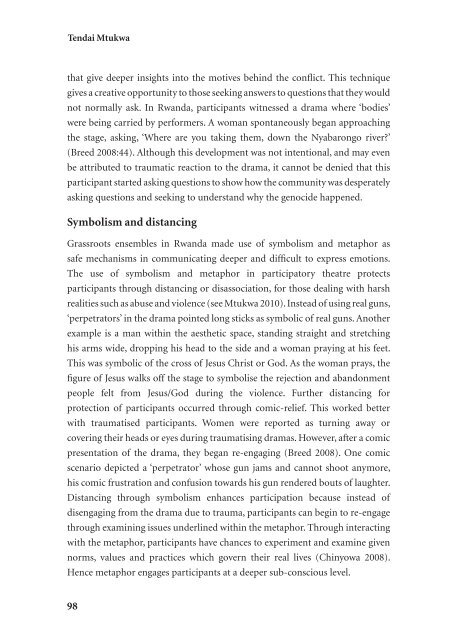ACCORD-ajcr-2015-1
ACCORD-ajcr-2015-1
ACCORD-ajcr-2015-1
- No tags were found...
Create successful ePaper yourself
Turn your PDF publications into a flip-book with our unique Google optimized e-Paper software.
Tendai Mtukwa<br />
that give deeper insights into the motives behind the conflict. This technique<br />
gives a creative opportunity to those seeking answers to questions that they would<br />
not normally ask. In Rwanda, participants witnessed a drama where ‘bodies’<br />
were being carried by performers. A woman spontaneously began approaching<br />
the stage, asking, ‘Where are you taking them, down the Nyabarongo river?’<br />
(Breed 2008:44). Although this development was not intentional, and may even<br />
be attributed to traumatic reaction to the drama, it cannot be denied that this<br />
participant started asking questions to show how the community was desperately<br />
asking questions and seeking to understand why the genocide happened.<br />
Symbolism and distancing<br />
Grassroots ensembles in Rwanda made use of symbolism and metaphor as<br />
safe mechanisms in communicating deeper and difficult to express emotions.<br />
The use of symbolism and metaphor in participatory theatre protects<br />
participants through distancing or disassociation, for those dealing with harsh<br />
realities such as abuse and violence (see Mtukwa 2010). Instead of using real guns,<br />
‘perpetrators’ in the drama pointed long sticks as symbolic of real guns. Another<br />
example is a man within the aesthetic space, standing straight and stretching<br />
his arms wide, dropping his head to the side and a woman praying at his feet.<br />
This was symbolic of the cross of Jesus Christ or God. As the woman prays, the<br />
figure of Jesus walks off the stage to symbolise the rejection and abandonment<br />
people felt from Jesus/God during the violence. Further distancing for<br />
protection of participants occurred through comic-relief. This worked better<br />
with traumatised participants. Women were reported as turning away or<br />
covering their heads or eyes during traumatising dramas. However, after a comic<br />
presentation of the drama, they began re-engaging (Breed 2008). One comic<br />
scenario depicted a ‘perpetrator’ whose gun jams and cannot shoot anymore,<br />
his comic frustration and confusion towards his gun rendered bouts of laughter.<br />
Distancing through symbolism enhances participation because instead of<br />
disengaging from the drama due to trauma, participants can begin to re-engage<br />
through examining issues underlined within the metaphor. Through interacting<br />
with the metaphor, participants have chances to experiment and examine given<br />
norms, values and practices which govern their real lives (Chinyowa 2008).<br />
Hence metaphor engages participants at a deeper sub-conscious level.<br />
98


